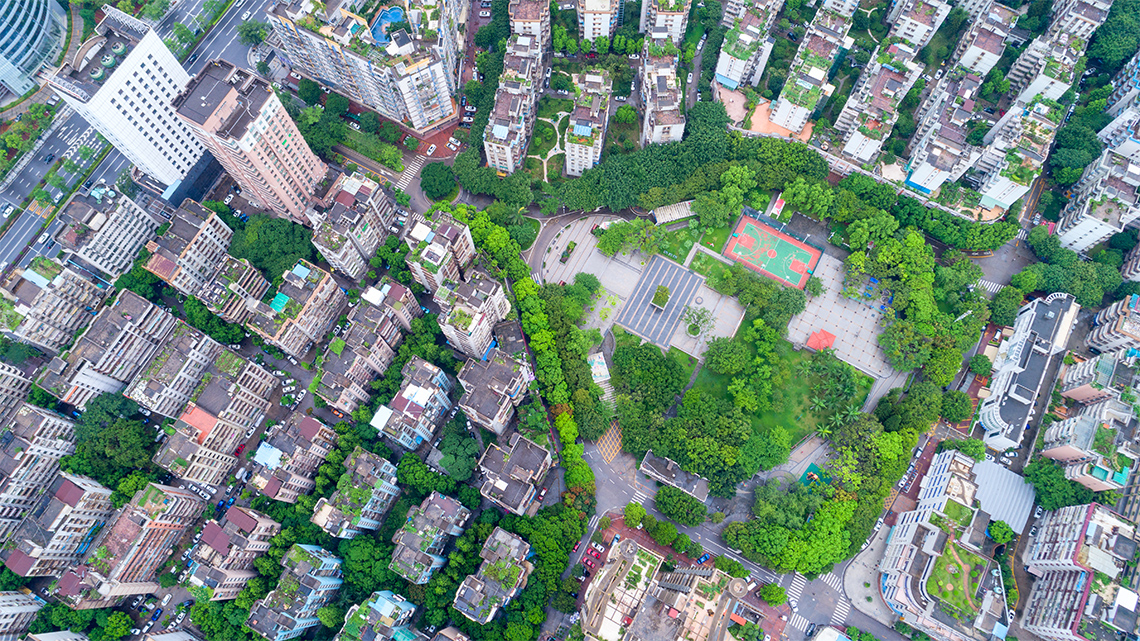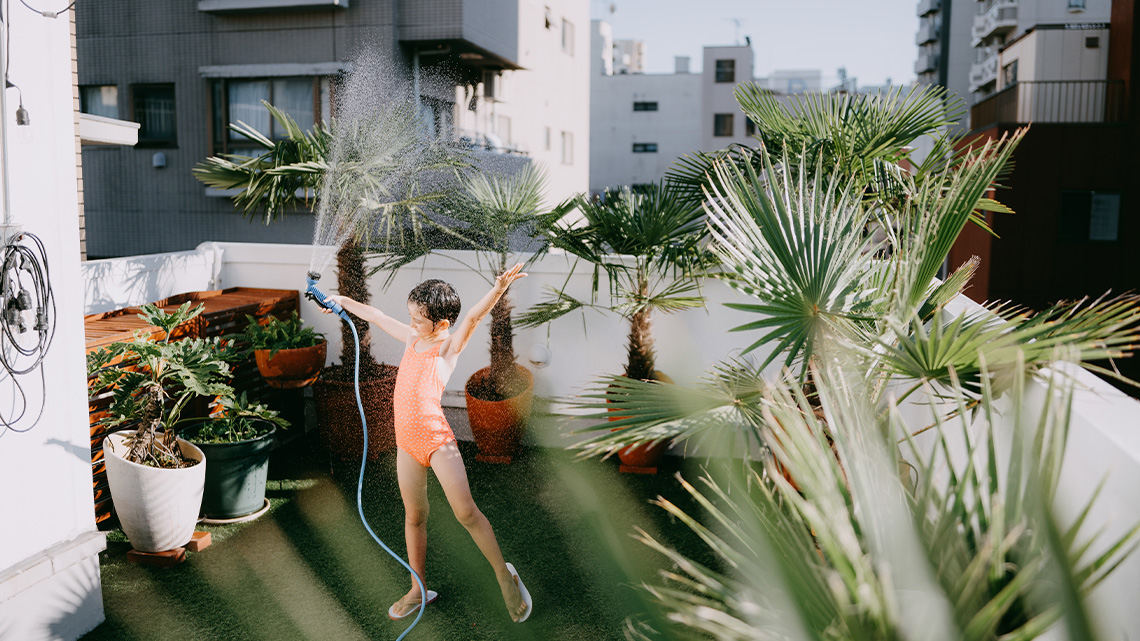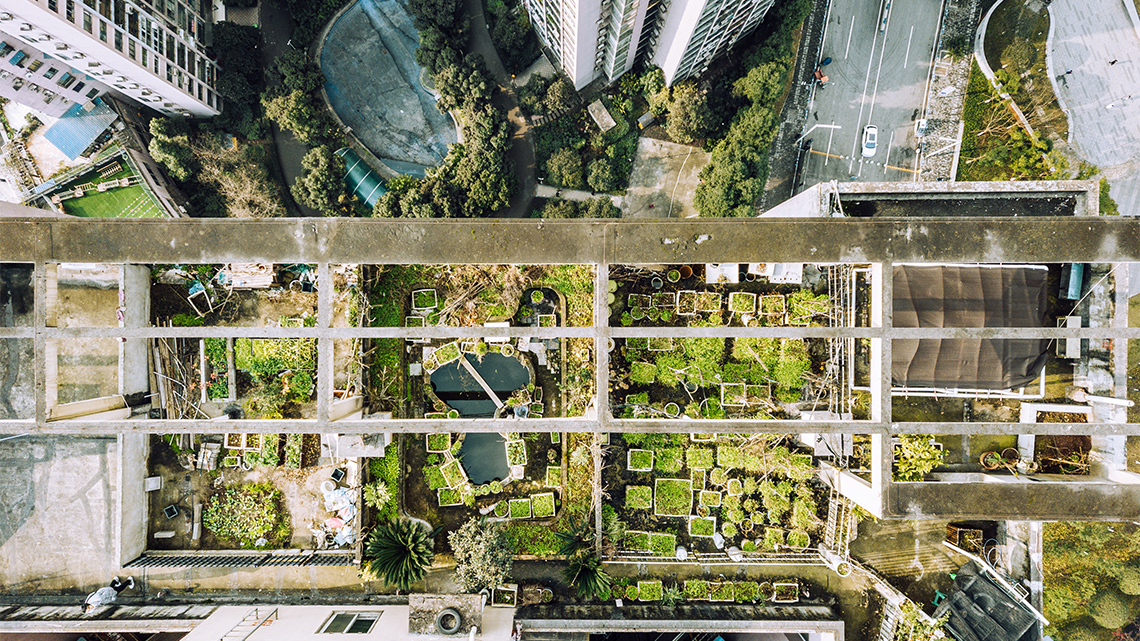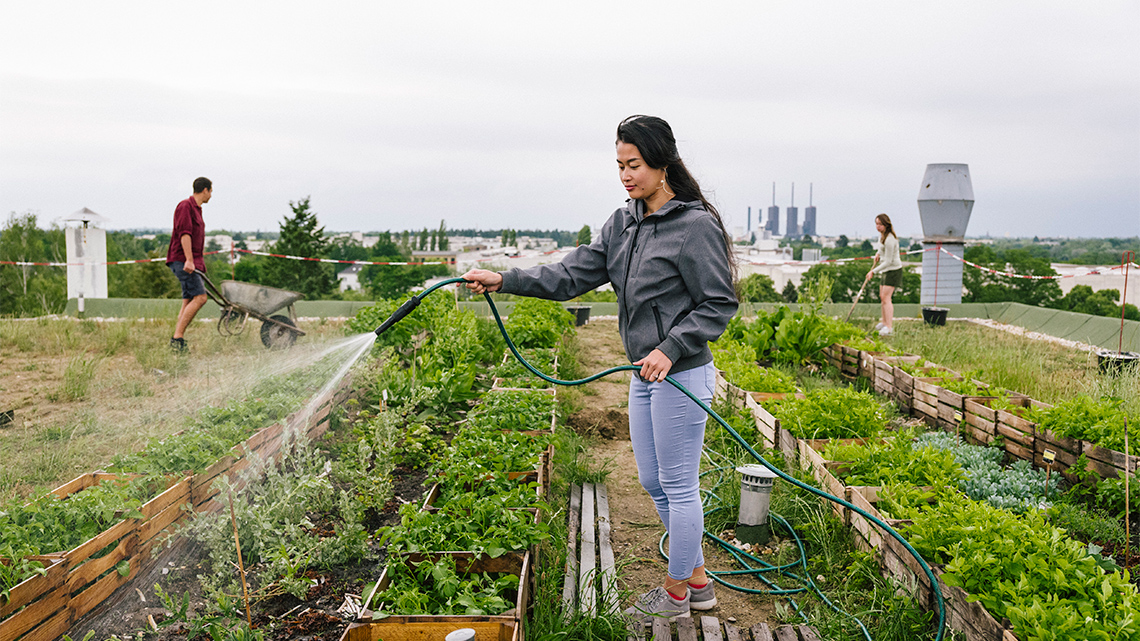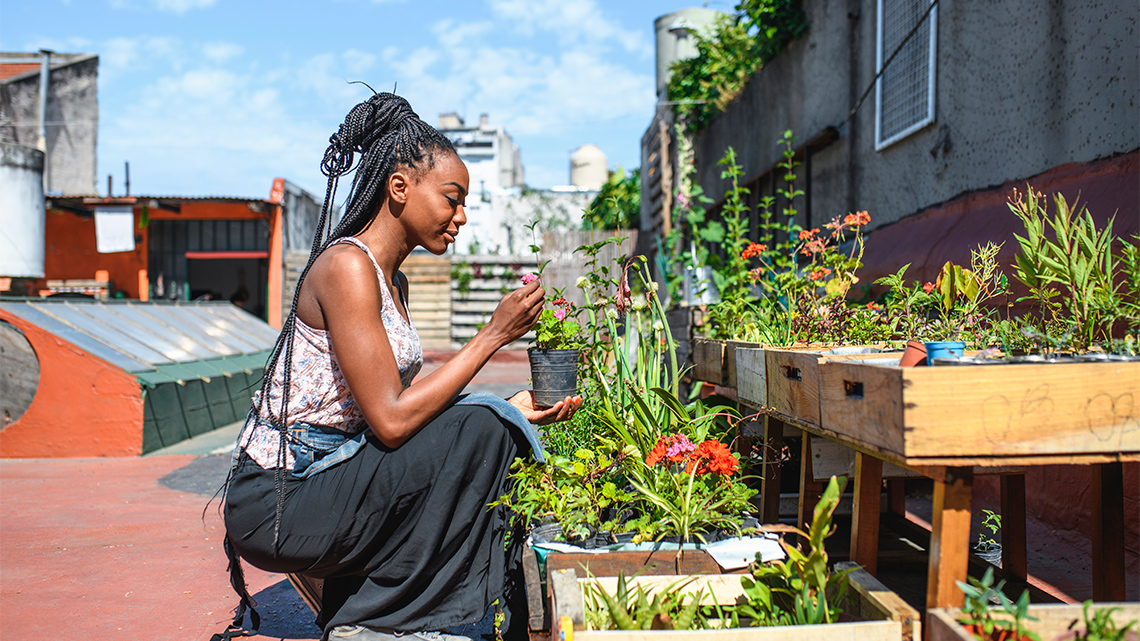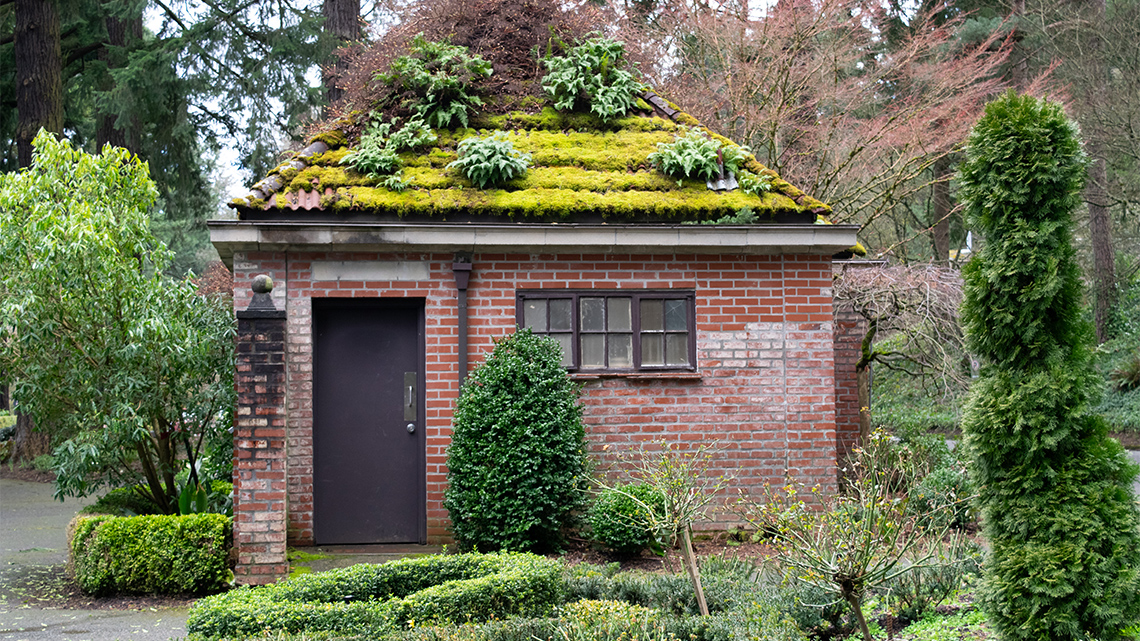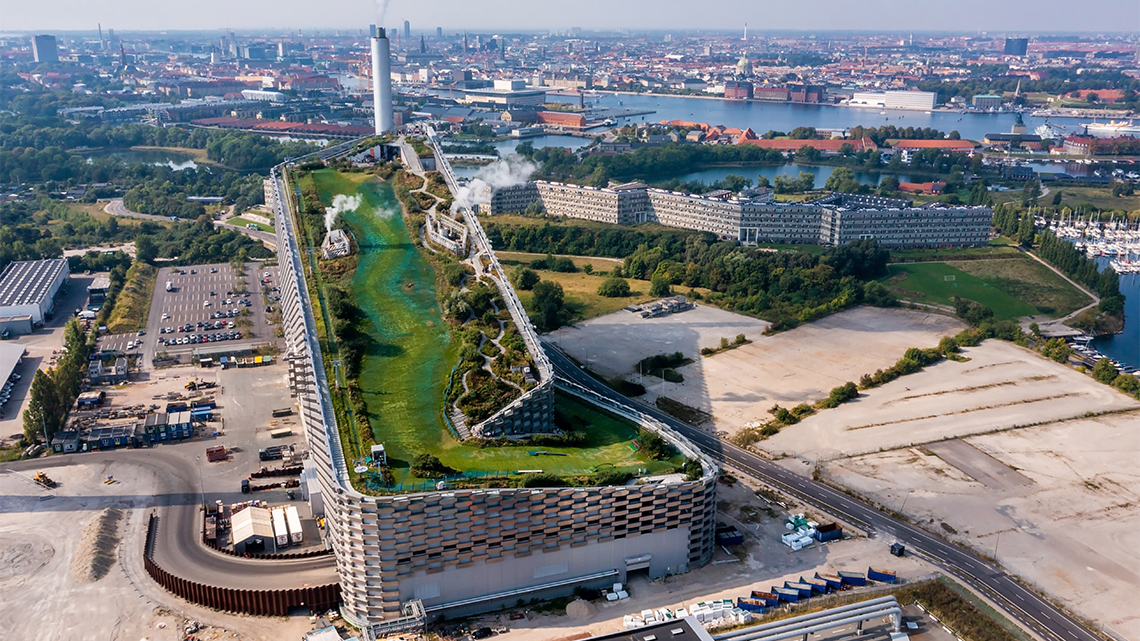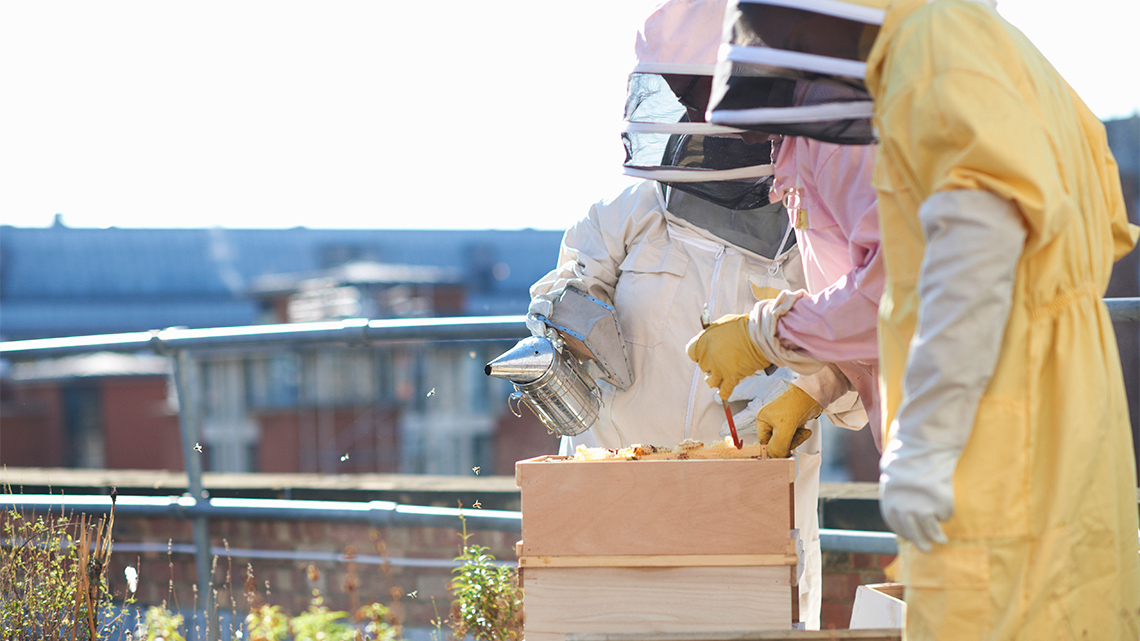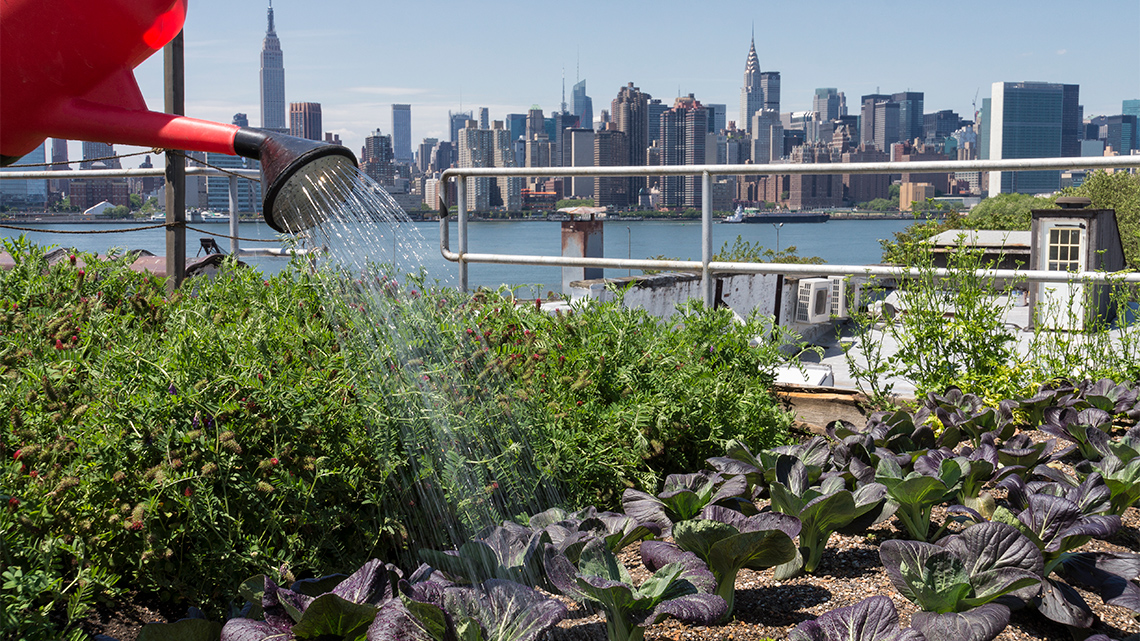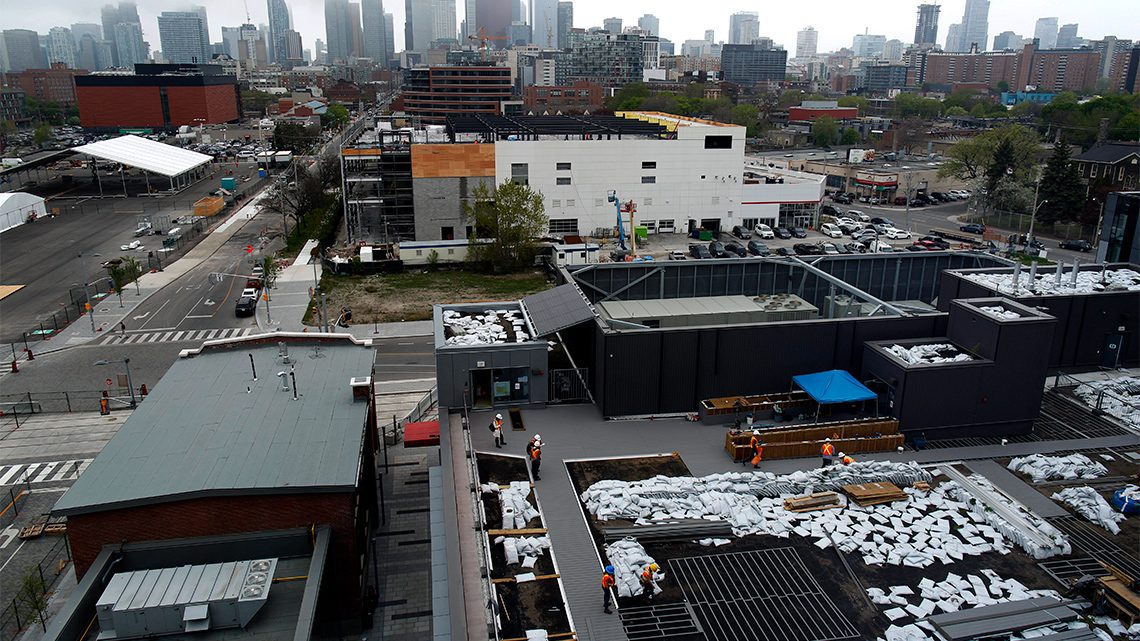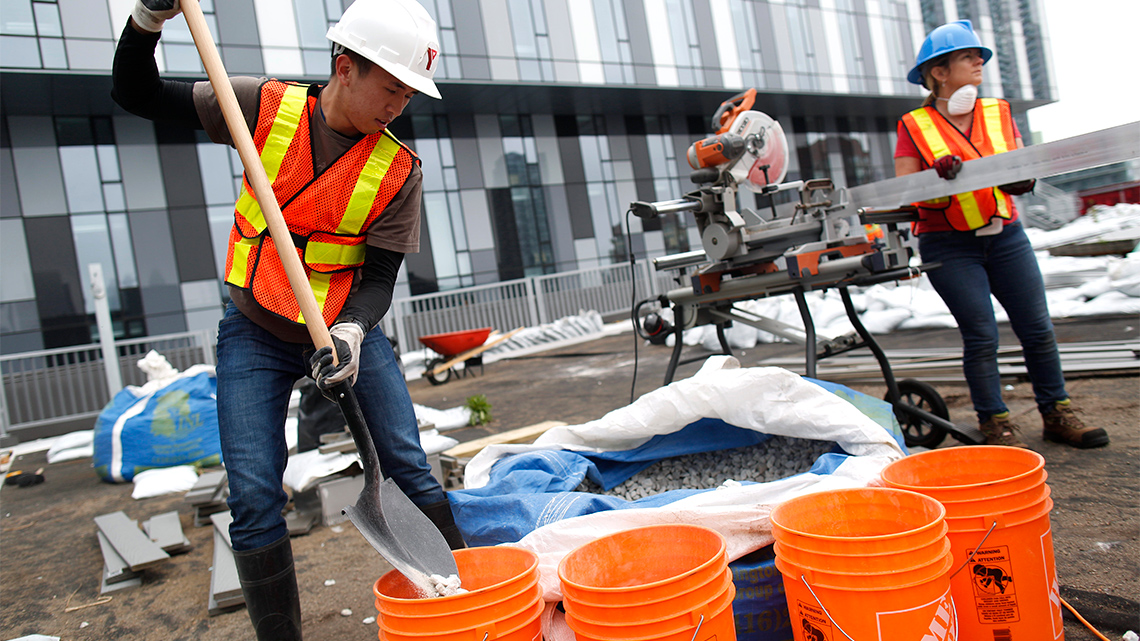Minds On
What are green rooftops?
Have you ever seen a green roof before? If so, where?
Green roofs exist in many cities all around the world. They are built on top of building roofs and consist of a variety of plant species.
Explore the following carousel of green roofs and rooftop gardens from around the world.
Brainstorm
Rooftop gardens
People often use green roofs as a rooftop garden – a place where they can grow fruits, vegetables, and herbs. Brainstorm responses to the following questions:
- Why do you think someone might build a green roof or rooftop garden?
- What would a rooftop garden be used for?
- Do you think rooftop gardens are positive or negative for people and buildings? Why do you think this?
Record your brainstorm using a method of your choice.
Action
Local rooftop garden versus a green roof
A rooftop garden is seen as a way to grow food locally. It can be as simple as placing planting containers or potted plants on top of a roof that can support the added weight and is safe for people to visit.
Rooftop gardens are found in local communities and are generally helpful to people who live in these communities in the city and need more options for growing fresh food.
However, a green roof is when the garden actually becomes the entire roof and has many more benefits beyond food. In this learning activity you will be exploring both rooftop gardens and their use for food, and the many benefits of a green roof, including how engineers design and build them.
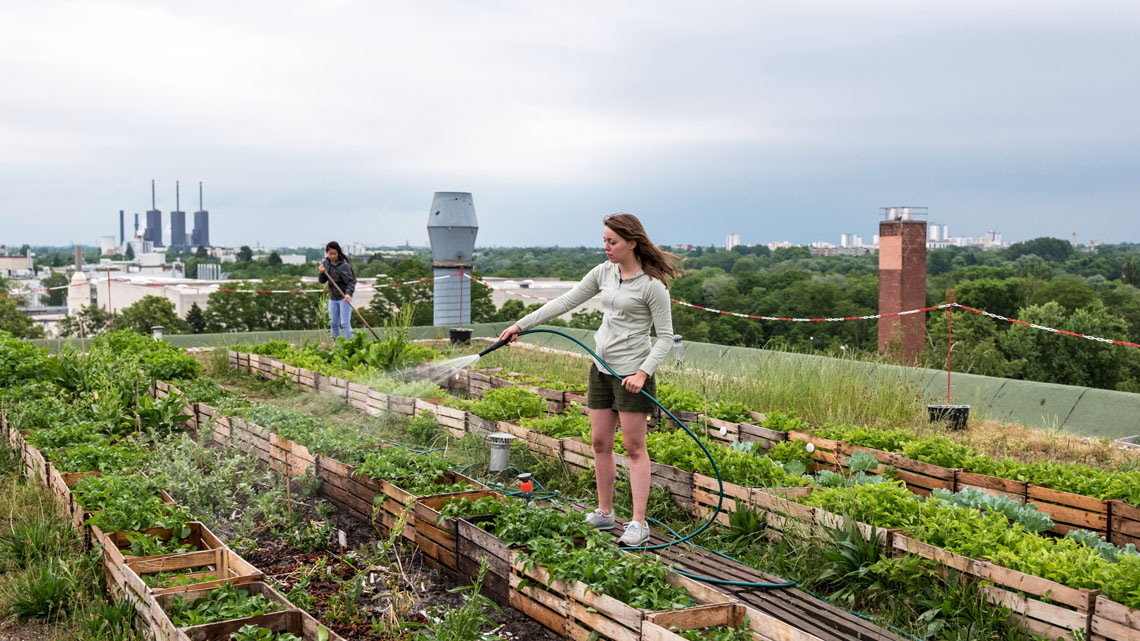
Benefits of rooftop gardens and green roofs
Cities are always growing! People who live in cities try to find ways to provide healthy and safe food for all of the people who live there.
Sometimes, in a city, finding space for plants and gardens to grow can be difficult. Rooftop gardens are one way to turn an unused, or forgotten space, into a place where safe and healthy food can be grown for local residents.
Check out the following Monty Don’s American Gardens video to learn more about a rooftop garden in New York!
When you are finished exploring the video answer the following questions:
- What vegetables did you observe?
- Do you think an urban rooftop farm is a good way to provide food to big cities? Why or why not?
- Why should large cities consider having a rooftop garden?
Record your answers using a method of your choice.
Based on the video, sort the following information in “Benefits” or “Limitations” of locally grow food.
A benefit is an advantage, or good thing about the rooftop garden.
A limitation is a restriction or something that is difficult about having a rooftop garden.
Did You Know?
Native Child and Family Services, Toronto, Ontario
At the Native Child and Family Services (NCFST) a rooftop garden was installed that recognizes traditional Indigenous cultural in a city setting. They chose perennials, shrubs, and trees that would be recognized by the Haudenosaunee who live on the land that later became Toronto. The garden also includes traditional Anishinaabe medicines, such as cedar, sweet grass, sacred tobacco, and sage. These are called the four sacred medicines.
Along with the four sacred medicines, is the three sisters crop – corn, beans, and squash. Traditional Haudenosaunee farming practices planted these three seeds together because they help each other grow. Learn more about the three sisters crop from Hope, in the video below.
Along with these traditional Indigenous medicines and crops, the NCFST provides a chance for children to visit and learn about traditional Indigenous ways of life, and provides a meeting place for the community. It includes play areas, log seating, and a fire pit as well.
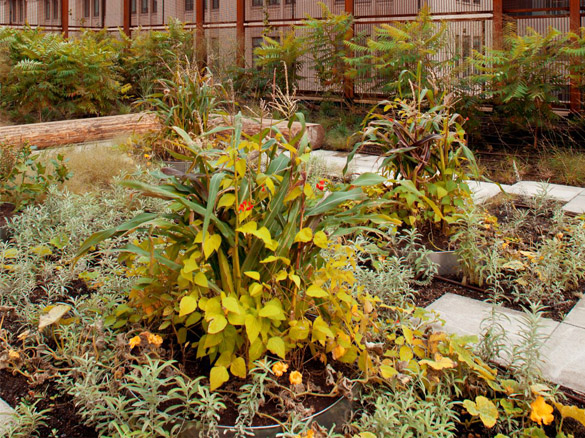
The Sisters Garden at the Native Child and Family Services of Toronto.
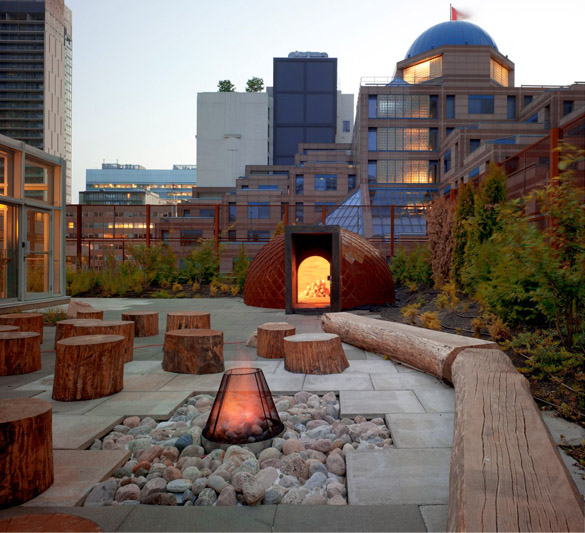
The Native Child and Family Services of Toronto.
Reflect on the following questions:
- What traditional Indigenous plants did they grow at Native Child and Family Services in Toronto?
- Why do you think they chose these?
Record your answers using a method of your choice.
Green roofs
Food is only one of the many benefits that a green space on a roof can provide to a building and community. Some green spaces are not used for food and are usually referred to as green roofs instead of rooftop gardens.
Explore the following NPR video entitled “How Green Roofs Can Help Cities” to learn about some of the other benefits of green roofs.
Now explore the following carousel of green roofs.
Now that you have explored the differences between rooftop gardens and green roofs, let’s check your understanding! Consider the following statements and choose if it is true or false.
Engineering green roofs
When designing a green roof there is a lot that an engineer needs to think about. Engineers apply the science and math of forces, loads, heat transfer, material properties, and energy to make sure a building provides a total system that supports a rooftop garden. There are many diverse kinds of engineers who each work on different parts of a rooftop garden design.
In the following Matching activity, try to choose the type of engineer that best fits the role they play in designing a green roof.
There are so many diverse engineers that are involved in designing and building a green roof. To create the best design possible, engineers use the engineering design process to brainstorm ideas, draw designs, build designs, and then test them out.
Engineering design process

In Science we ask questions to help us figure out what the problem is.

Brainstorming is when you think about ideas like how to solve a problem.

When you plan something, you think about the steps you have to follow and the materials you will need.

It’s time to build. Gather your materials and your plan and start building!

Testing lets you try out your design to see if it works.

Improving is about making your design even better.

Sharing what you have learned lets other people know about your topic too!
Brainstorm
Think like an engineer!
- What do you think engineers would need to think about when they are designing a green roof?
Brainstorm your ideas using a method of your choice.
Press the following tabs to explore some of the things that engineers need to think about.
Engineers need to begin by thinking, what can I do to make sure this structure remains stable? They will explore the conditions of the roof, and the roofs’ ability to hold a load. A load is the weight of any objects that would be on the roof.
The structural design of the roof needs to be able to hold a certain weight, be able to have specific waterproofing systems installed and be able to withstand strong winds. Before they even begin to design, these are things an engineer would consider.
Engineers need to consider what materials would be best to build the rooftop garden – wood, metal, glass? They would consider factors like:
- the weight of the material – is it going to be too heavy for a roof?
- the durability of the material – is the material strong?
- the quality of the material – will it last a long time?
- the cost of the material – how much will be needed? is it too expensive?
- best material for the job – what types of plants will be planted? how does this affect the type of materials used?
Since natural soils are very heavy, especially when they are wet, engineers typically use lightweight materials made from high quality composted or recycled materials. They need to be able to hold on to the water without falling apart.
Every green roof will require access for people to water, take care of, and maintain the plant species on the roof. The green roof might require repairs or changes over the years. So, engineers design the green roof with this in mind. They also want to make sure that the green roof is safe for people to work on, and that it will remain safe for years to come.
Case Study: YMCA
The YMCA is a place that can be found in many different cities across Canada. They offer different services, such as a gymnasium, swimming pool, child care, camps, and other services. The YMCA in Greater Toronto created a green roof with a running track, outdoor yoga studio, and benches along the way to rest. It provides lots of benefits to people who live there, such as:
- benefits of the vegetation grown
- less rainwater runoff
- energy efficient
- less heat
This green roof aligns with their mission to “build stronger communities and in this case, promote an environmentally-friendly space for our generations to enjoy today and in the future.”
Explore the following carousel of the YMCA green roof being built.
The YMCA in Toronto is not the only YMCA with a green roof! The YWCA in Vancouver, British Columbia, has a rooftop garden that grows more than 1500 pounds of food each year! Fruits and vegetables such as kale, tomatoes, beets, cucumbers, peppers, blackberries, raspberries, beans, and much more, are grown and used to provide fresh and healthy meals to families nearby.
A Métis herbalist and educator began an Indigenous plant garden as part of the rooftop garden at the YWCA. She grows salal, huckleberries, yarrow, and much more, that is harvested and used for educational workshops, cultural connections, and Indigenous ceremonies.
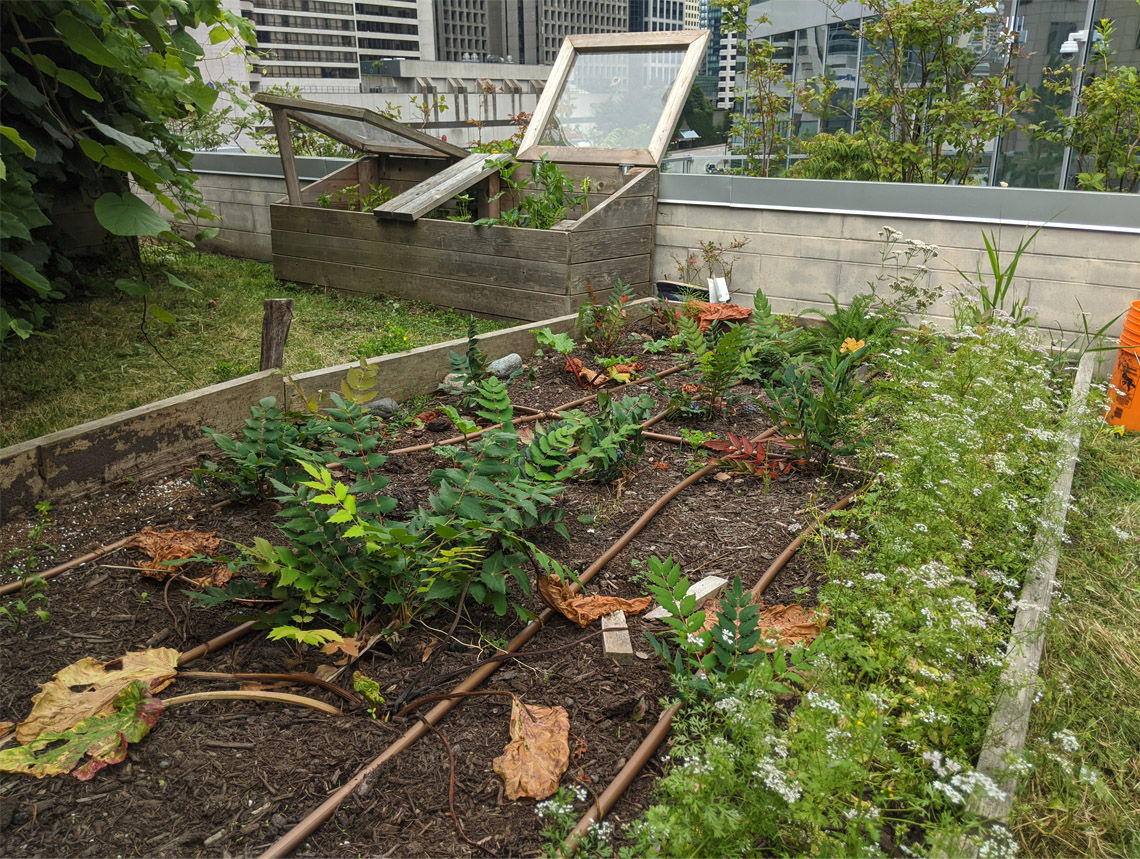
Consolidation
Reflection
Respond to the following reflection questions using a method of your choice.
- What are some of the benefits and limitations of locally grown food and rooftop gardens?
- What should an engineer consider when designing and building a rooftop garden?
Your turn to design!

In this learning activity, you explored the Engineering and Design process. Part of this process is to design something, such as a structure or product. Now it’s your turn to design!
Brainstorm a creative design for a rooftop garden for your school, or another building in your community. Begin by responding to the following questions:
- Why do you think this would be a good spot for a rooftop garden?
- How do you think people would interact with your rooftop garden?
- What kind of plants would you like in your design?
Begin by completing the Rooftop Garden Design Worksheet in your notebook or using the following fillable and printable document. If you would like, you can use speech-to-text or audio recording tools to record your thoughts.

Press the Activity button to access Rooftop Garden Design Worksheet.
Activity (Open PDF in a new window)Now create an image or detailed description of your rooftop garden using a method of your choice. Be sure to label what materials you think you might need!
When you are finished, make a list of questions you would need to ask an engineer before you began to build your green roof or rooftop garden. For example, you might ask an engineer: How much weight can this roof hold? What materials do you recommend?
Record your questions for an engineer using a method of your choice.
Reflection
How do you feel about what you have learned in this activity? Which of the next four sentences best matches how you are feeling about your learning? Press the button that is beside this sentence.
I feel…
Now, record your ideas about your feelings using a voice recorder, speech-to-text, or writing tool.
